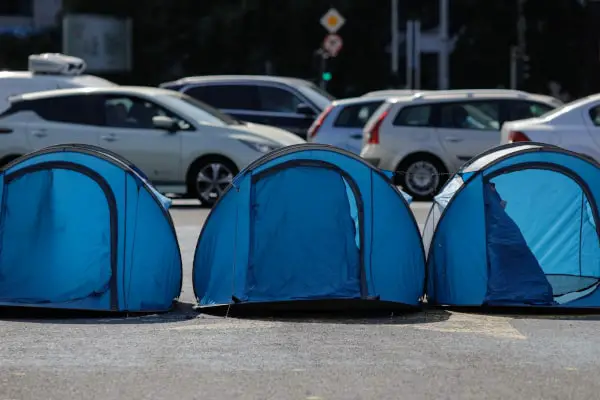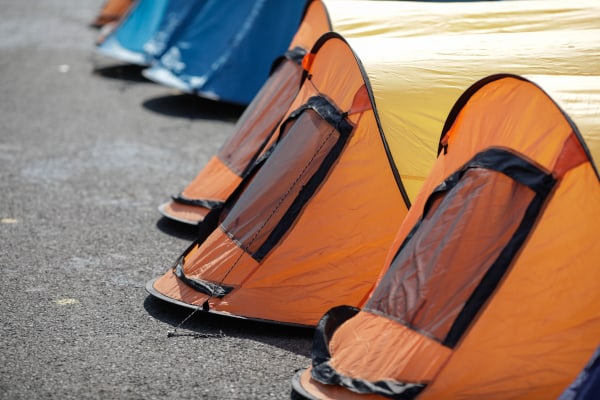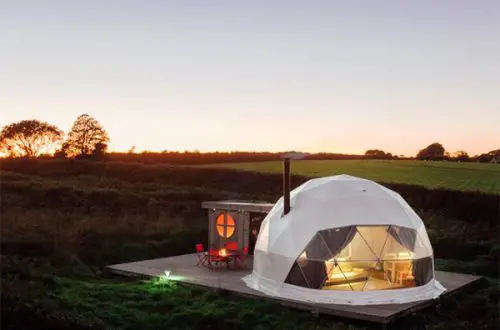How to Set Up a Camping Tent on Concrete?
Table of Contents
If you’re like most people, you probably think of tent camping as being an outdoor activity. However, did you know that you can also set up a camping tent on a concrete slab?
In this guide, we’ll show you how to do it.
So if you’re ever in a situation where there is no available outdoor space for camping, don’t worry – you can still set up your tent!
On a concrete floor, tent stakes cannot be driven into the hard ground. Heavy rocks or some weights have to be used to keep the tent in one place. Freestanding tents don’t need stakes to stand, but especially non-freestanding tents do need some extra support. Remember to clean any debris under the tent to avoid damage in the tent floor.

Clear the Area Under the Tent
The first step is to clear the chosen area where you will be pitching your tent. Make sure that there are no rocks, sticks, or other debris that could puncture the tent floor.
Collect or sweep away any debris from the area. If there are large rocks in the area, try to move them somewhere else.
Put A Tarp Under the Tent
If you’re setting up your camping tent on concrete, it’s a good idea to put a tarp down first. This will help protect the tent floor from damage.
The tent floor is the most vulnerable part of a tent, so it’s important to take steps to protect it, and to prevent holes from forming in the fabric.
Assemble the Tent
Now that you’ve cleared the area and put down a tarp, it’s time to assemble the tent. Refer to the instructions that came with your tent for more information on how to fix the tent frame.
Depending on the type of the tent you have, you may need to assemble it in a specific way in order to ensure that it is stable and won’t be blown away. Assembling your tent at home at least once is a good idea, so you know how to do it properly when you’re out camping.

Anchor the Tent with Weights
If your tent is not freestanding, you’ll need to anchor it down with weights. This will help prevent the wind from blowing it away.
You can use rocks, sandbags, tent weight bags, or even water jugs as great anchors. You can also carry exercise weights or weight bags to be used as tent weights if you’re camping in an area with a lot of strong wind. You may also improvise weight from buckets filled with sand if you have buckets around.
Put each weight gently on the ground around the perimeter of the tent or into the corners and spread them out evenly.
If you are camping with car, it is easier to carry around such weights. Simply put them in the car and drive to the campsite.
Freestanding Tents
Freestanding tents don’t necessarily need a larger rock in each corner. No tent poles or stakes are needed for those, as each tent leg stands in itself.
It is important though to place the rocks in each corner so that the wind wouldn’t knock down the tent. You can also use some ropes to tie off your freestanding tent to nearby trees or poles, if there are any available.
Non-Freestanding Tents
If your tent is not freestanding, you’ll need to use stakes to secure it to the ground.
On concrete, this is not feasible. You can use concrete or metal weights in place of stakes. Make sure that the weights are heavy enough to keep the tent from blowing away in strong winds. Preferably place them in the four corners of the tent.
Setting around 10-20 lbs of weights per corner is a good guideline.

Canopy Tents
Canopy tents do not need to be anchored down since they are already designed to stand. However, you will need to use weights to keep them from blowing away in strong winds. Cinder blocks or buckets filled with sand work well as weights for canopy tents.
Don’t Sleep Directly on the Ground
If you’re sleeping in a camping tent on concrete floor, don’t sleep directly on the ground. The ground is hard and uncomfortable, and it will probably give you a sore back.
Instead, use a camping cot, a foam or an air mattress combined with your sleeping bag to make your sleep more comfortable. Using one or more of these items can also help to keep you warm and protect you from the cold ground.
Final Thoughts
Setting up a camping tent on concrete can be done, but it’s not as easy as setting it up on soil. By following the steps we’ve outlined in this blog post, you should be able to set your camping tent up successfully on concrete without any trouble.
We hope you have a great time camping this year and that our tips will make the process easier for you.



